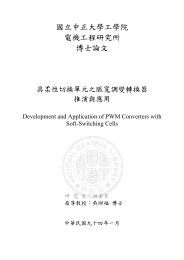Syntax of the Bi Comparative Construction in Mandarin Chinese
Syntax of the Bi Comparative Construction in Mandarin Chinese
Syntax of the Bi Comparative Construction in Mandarin Chinese
Create successful ePaper yourself
Turn your PDF publications into a flip-book with our unique Google optimized e-Paper software.
<strong>Syntax</strong> <strong>of</strong> <strong>the</strong> <strong>Bi</strong> <strong>Comparative</strong> <strong>Construction</strong> <strong>in</strong> Mandar<strong>in</strong> Ch<strong>in</strong>ese<br />
(53) (Hs<strong>in</strong>g 2003:76)<br />
CP<br />
3<br />
Opi[+wh] C’<br />
3<br />
C FP<br />
2<br />
wh-phrase F’<br />
2<br />
F’ IP (elided)<br />
2<br />
I’<br />
2<br />
I<br />
32<br />
[E]<br />
(54) (Hs<strong>in</strong>g 2003: 77)<br />
VP<br />
2<br />
V CP<br />
2<br />
Spec C’<br />
g 2<br />
Opi[Q] C FP<br />
shi 2<br />
DP F’<br />
g 2<br />
shei F IP (elided)<br />
qp<br />
Zhangsan zuotian yujian ti<br />
In sluic<strong>in</strong>g sentences, E feature makes wh-adjunct moved out, <strong>the</strong>n <strong>the</strong> left elements<br />
are deleted <strong>in</strong> PF level. Hence, <strong>the</strong> wh-phrase is left. On <strong>the</strong> contrary, <strong>in</strong> BCC <strong>the</strong><br />
deleted part is wh-phrase. Consequently, we cannot suppose FP <strong>in</strong> BCC have similar<br />
characters.<br />
中正大學 e-Thesys (94 學年度)





